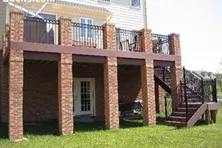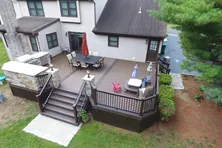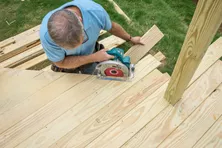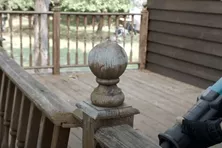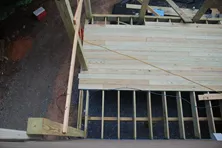How to Install Deck Girder, Cantilever or Drop Beams
A girder, cantilevered or drop beam is a structural member positioned below the joists to support the weight of the frame. Cantilevered beams are stronger than flush style beams because they rely on the strength properties of the wood rather than the individual mechanical and fastener connections.
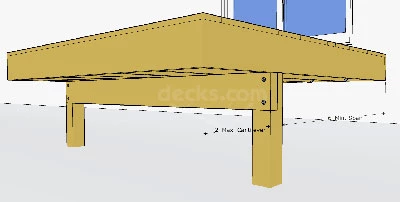
Notching posts lends itself well to cantilevered beam construction, as does the practice of chamfering the corners of the deck. In order to install a cantilevered beam you must have enough clearance below the joists to install the beam. Allow for a minimum of 6” airspace between the ground and the bottom of the beam.
Always remember to install the beam crown side up so the weight of the deck will level itself. If you install a beam crown side down the deck is more likely to sag. On the negative side cantilevered beams can create a ledge underneath the joists that can become a home to birds and insects nests as well as block views and limit headroom.
The American Wood Council’s Wood Frame Construction Manual states that beams can generally cantilever up to 1/4 their span over a post. This design criterion is generally limited to beams supporting equivalent joist lengths in its span as in it’s cantilevered sections. For example, a double 2x12 beam spanning 12 feet can cantilever up to 3 feet over a post. While this maximum is allowed in conventional code-compliant design, it may not provide the comfort and stability on the deck surface desired by the occupant.
How to Decorate Deck Support Columns
Browse some examples of decorative deck support posts for tall decks.
Building a Deck Around a Tree
Learn how to build a deck around a tree to allow the tree to grow and not damage its root system while digging footings.
How to Create Strong Post-to-Beam Connections
Learn how to create a positive structural connection for your post to beam connections. Use lag bolts, through bolts with washers, support cleats and hardware connectors.
Decking Patterns
Installing your decking at a 45-degree angle is a popular style for decks. This can be done to reduce decking seams or just for appearance.
10 Common Deck Building Mistakes & How to Avoid Them
Building a deck can be a complicated process. Learn how to avoid falling into common deck building pitfalls with tips and advice from the experts at Decks.com.
Introduction to Decking
Spacing between deck boards provides several critical functions, such as drainage & drying. Learn how to space and stagger deck boards at Decks.com.
More Helpful Resources
Explore Articles by Topic

Footings
Information related to installing frost footings for decks

Framing
Learn structural framing methods

Decking
Learn about wood and composite decking materials

Stairs
An in-depth look at the complex issue of how to build stairs

Railings
How to install guardrails and handrails to meet IRC code

Features
An overview on water drainage, benches, planters and lights

Design
The basics of deck design

Planning
Learn about permits and working with contractors

Porches & Patios
Build a covered deck to enjoy all seasons

Ledger
Proper attachment techniques

Care
Maintain your deck to maintain your investment

Materials
An overview on water drainage, benches, planters and lights
Why is Joist Protection so Important for Your Deck?
If you’ve ever seen a piece of wood left out in the weather for any period of time, you know what happens: decay. Whether through wet rot, insect damage, or mildew, the fibers begin to break down.
Building Your Deck For A Hot Tub
Learn how to build a deck to properly support a hot tub or spa. Hot tubs are very heavy. Never place a hot tub on a deck that wasn't designed for the additional load.
Determining Deck Beam Height
Learn how to measure in order to set your posts to properly position your deck beam to the correct height. We recommend sloping your deck to shed water away from the house.
Building an Outdoor Space with James DeSantis
Composite decking can not be placed directly on concrete. But a substructure can solve for this. Explore this deck project with James DeSantis
How to Demolish & Remove a Deck
At some point, it might become necessary to remove an old deck, due to age or condition. Learn more about what's involved in a deck demolition and removal project.
Explore Articles by Topic

Footings
Information related to installing frost footings for decks

Framing
Learn structural framing methods

Decking
Learn about wood and composite decking materials

Stairs
An in-depth look at the complex issue of how to build stairs

Railings
How to install guardrails and handrails to meet IRC code

Features
An overview on water drainage, benches, planters and lights

Design
The basics of deck design

Planning
Learn about permits and working with contractors

Porches & Patios
Build a covered deck to enjoy all seasons

Ledger
Proper attachment techniques

Care
Maintain your deck to maintain your investment

Materials
An overview on water drainage, benches, planters and lights




